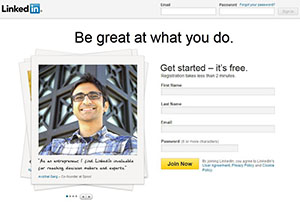 After researching endless solutions to common independent recruitment problems, recruiters may find themselves more frustrated, and unable to see why their system is just not working anymore. Too much to process with a lack of resources can slowly, yet surely, cause damage to your recruitment brand. Here are three suggestions to improve your brand and recruitment process: Read the rest of this entry »
After researching endless solutions to common independent recruitment problems, recruiters may find themselves more frustrated, and unable to see why their system is just not working anymore. Too much to process with a lack of resources can slowly, yet surely, cause damage to your recruitment brand. Here are three suggestions to improve your brand and recruitment process: Read the rest of this entry »
3 Ways to Improve a Failing Recruitment Process
by Sarah FreiburgerRelevant Networking
by Veronica Blatt Mel Kettle is a communications and social media consultant, speaker, blogger, educator, coach, bookworm, obsessive foodie and eatie, and a budding photographer. She blogs on marketing and social media at www.melkettle.com.au. Mel is passionate about working with organisations to show them how to communicate effectively so they can develop communities, share their stories and raise awareness. She particularly enjoys working with people who want to make a difference to other people’s lives. In her spare time Mel writes a food blog, The cook’s notebook.
Mel Kettle is a communications and social media consultant, speaker, blogger, educator, coach, bookworm, obsessive foodie and eatie, and a budding photographer. She blogs on marketing and social media at www.melkettle.com.au. Mel is passionate about working with organisations to show them how to communicate effectively so they can develop communities, share their stories and raise awareness. She particularly enjoys working with people who want to make a difference to other people’s lives. In her spare time Mel writes a food blog, The cook’s notebook.
I used to go to a lot of networking events – easily one or two a week. And then life got a little busy (that networking was paying off!), and I stopped.
While I do a huge amount of networking via Twitter, and have a lot of referrals come to me that way, I miss the face-to-face interactions that going to a networking event provides. Read the rest of this entry »
NPAworldwide Survey: Recruitment Business Conditions
by Veronica BlattTwice each year, we survey our members regarding recruitment business conditions in order to document past results and also get a sense of what the future might hold. Some of the notable results:
- NPAworldwide members are located in 32 countries, on 6 continents
- The majority of survey respondents (76%) serve both clients and candidates
- 77% indicated that recruitment business conditions over the past 180 days are the same or better than they were a year ago
- Among survey respondents, the strongest vertical was manufacturing / mining / construction / supply chain.
How to Collect $25,000 on Placements that You Have Already Made
by Veronica Blatt Today’s guest blogger is Wilson Cole. He is the founder and CEO of Adams, Evens & Ross, the nation’s largest credit and collection agency designed exclusively for the staffing and recruiting industry. In 2008 he was inducted into INC Magazine’s, “INC 500” for being the CEO of Adams, Evens & Ross, the 307th fastest-growing privately held company in America.
Today’s guest blogger is Wilson Cole. He is the founder and CEO of Adams, Evens & Ross, the nation’s largest credit and collection agency designed exclusively for the staffing and recruiting industry. In 2008 he was inducted into INC Magazine’s, “INC 500” for being the CEO of Adams, Evens & Ross, the 307th fastest-growing privately held company in America.
Clients are starting to tell us that the economy is picking up, and for the first time in years they are starting to feel optimistic. This is a good thing. I am seeing cash flows improve from debtors as well, so we will all keep our fingers crossed and hope that this positive sign continues.
One of the issues that I have seen a very large increase in is back-door hires and conversion. I would be willing to bet that if I had 100 clients go back and check their candidates, 25% of our clients would find that at least one of their candidates was hired over the last 12 months. Yes this is a problem, but it is also a big opportunity. If you are willing to take the time and spend an afternoon checking LinkedIn, I would bet that you could find $15,000 to $45,000 in placements.
The reason I bring this point up is because the economy is improving, and debtors now have more money in their bank accounts. The chances of them paying you once you bring the hiring of your candidate to their attention has greatly increased from a few years ago. Then, debtors used to prefer to hold on to their money and prefer that you sue them because it bought them more time. Now, with sales increasing and cash flow improving, the debtor will more likely just cut a check vs. having to spend the money on an attorney.
So what should you do if you learn that one of your temps or candidates was hired by your client? The following suggestions may be helpful:
- Pull an inventory of your paperwork. Do you have a signed agreement? Do you have an email trail? Can you show clearly that the client knew it was your candidate and if they hired that individual, then a fee would be owed?
- Reach out to the hiring company and inform the company of its unfortunate “oversight.”
- Send the company an invoice. If you have to guess what is owed because you do not know what they are paying your candidate, then take an educated guess. Use the higher side of your best guess without being out of line of course (if the candidate’s potential hire meant the company had to pay the fee, then contact the former candidate to find out what he or she is being paid).
- Send an invoice with a specific date. For example, don’t have the invoice say net 10 days or due upon receipt. Have your invoice read 5 – 10 days from the day you cut the invoice. If today is March 2 then you would put Due March 12 — 20XX.
- Send the invoice, and wait until the first day after the invoice was to be paid.
- Then call and send a letter giving the client 5 days more. Give an exact date.
How to Make Sure You’re Hiring the Right People for Your Startup
by Veronica Blatt Our blog today comes from Nick Bowditch who has recently joined Forsythes Recruitment. Nick has come to Forsythes from Facebook where he was their Regional SME Manager (AUS/NZ). He has re-launched Forsythes’ IT/Tech/Startup recruitment division out of his home office on the Central Coast. He is currently managing recruitment assignments for Instagram, Twitter and Telstra just to name a few. Nick works with innovative startups and small businesses in Australia and internationally, presenting at conferences and inspiring others to take the leap into their own startups, as well as working with big brands helping them connect to small businesses and their communities better – both offline and online.
Our blog today comes from Nick Bowditch who has recently joined Forsythes Recruitment. Nick has come to Forsythes from Facebook where he was their Regional SME Manager (AUS/NZ). He has re-launched Forsythes’ IT/Tech/Startup recruitment division out of his home office on the Central Coast. He is currently managing recruitment assignments for Instagram, Twitter and Telstra just to name a few. Nick works with innovative startups and small businesses in Australia and internationally, presenting at conferences and inspiring others to take the leap into their own startups, as well as working with big brands helping them connect to small businesses and their communities better – both offline and online.
So your recruitment company has given you a shortlist of candidates to chat to about the vacant position with your startup. So how do you know you are hiring the right person? Think about these 4 things:
Are they doing something that you can’t?
Often in the startup phase you are bootstrapping the business or under some financial pressure. I am a big believer in hiring what you need rather than what you would ideally like. So the first hire – after you and the other co-founder(s) – is often the most important one. Will this next hire mean you can get some money in to then recruit further? Is the role that they will fill something that you and people already in the business could do if you were really pushed? I think hiring for skill gaps in your business is the way to think about it.
Do they share your vision?
Let’s face it, nobody is really going to share your vision, not the way you do. But you can reasonably expect them to be on board at least with what you are trying to do and what you think their role is in that. Unfortunately a lot of startups find out their new employee doesn’t share their vision for the business until they have sapped a lot of your resources and finances and it’s too late.
Do they need structure and a hiding place?
Startups are scrappy. Sometimes you are doing your job and sometimes you are doing stuff you never would have dreamed doing. The scrappiness of startups both attracts and frustrates people who work in that space but it can be a very rude shock if you are not prepared for it. If you work out that someone is used to working in a big corporate space where they can hide all day without it being obvious then you are probably not hiring the right person for your startup.
Understand what motivates them.
What do they want to achieve? What’s going to get the best out of them? What will totally frustrate them? Most importantly, are both you and they aligned on these things? You don’t have to know everything about them but understanding what motivates them is the number one way to ensure you are getting optimal performance from your new startup employee.
What’s been your experience with hiring the right – or wrong – people? What would you change next time?
International Recruitment: Expats or Local Talent?
by Dave Nerz I was recently asked some interesting questions by a global recruiter. They were interested to know about the numbers of executive and professionals leaving Brazil each year to take assignments outside the country and overseas. As you might guess, this is not easy info to find. If you have insights on where it is available please let me know.
I was recently asked some interesting questions by a global recruiter. They were interested to know about the numbers of executive and professionals leaving Brazil each year to take assignments outside the country and overseas. As you might guess, this is not easy info to find. If you have insights on where it is available please let me know.
Here is how I tried to answer the question that was posed… Read the rest of this entry »
What’s Wrong with Active Candidates?
by Veronica Blatt There is so much hype about passive candidates vs. active candidates. It seems like most recruiters, when pressed, will tell you that passive candidates, i.e. candidates who are not looking for a job but might be interested if the right opportunity came along, are the ‘gold standard’ of recruiting. Active candidates are sometimes overlooked or written off as undesirable, and I’m not sure that’s the smartest approach.
There is so much hype about passive candidates vs. active candidates. It seems like most recruiters, when pressed, will tell you that passive candidates, i.e. candidates who are not looking for a job but might be interested if the right opportunity came along, are the ‘gold standard’ of recruiting. Active candidates are sometimes overlooked or written off as undesirable, and I’m not sure that’s the smartest approach.
You know what I think? I think too many recruiters think “active candidates” = “unemployed candidates.”
The definition of an “active candidate” is one who is actively, currently, looking for a new role. It’s a big jump to automatically assume that candidate is unemployed. Consider the following examples of active candidates:
- Those who have reached the top of the payscale at their current company
- Those who have no more room for promotion at their current company
- Those who are caught up in a merger / acquisition that is likely to impact their job downstream (change in focus, consolidation, etc.)
- Those who work for bad managers (remember, employees don’t leave companies, they leave managers)
- Those who are interested in relocation for a variety of reasons
In some ways, I believe recruiting active candidates might be the smarter move — for one thing, you don’t have to convince them to leave what is familiar for something unknown. They have already emotionally separated themselves from their current employer and are ready to move on to something new. There is a high(er) likelihood they’ve already talked with their spouses, so the career move is not an out-of-the-blue shock. They’d probably like to remain employed until they find a new role, which means they probably aren’t shouting out their job search from every available rooftop, job board, or social media channel. Nothing undesirable about any of that, is there?
The goal (I think?) is to get the best person in front of your client. If the best person is someone who has already decided a career move is in order, would you NOT present them to your client? Would your client ‘pass’ on an interview? Probably not. Don’t be so quick to label active candidates or passive candidates; instead, focus on the *best* candidates.
What do you think? Has the “active” versus “passive” debate run its course? Why or why not?
Image courtesy of Stuart Miles / FreeDigitalPhotos.net



